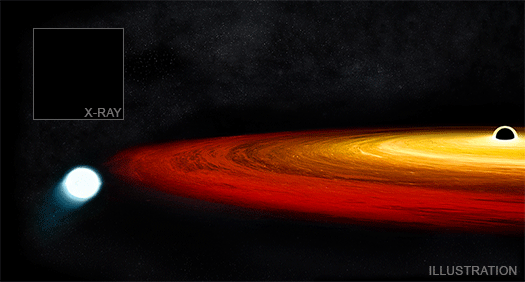Astronomers may have discovered a new kind of survival story: a star that had a close interaction with a giant black hole and managed to survive and tell its story through exclamations of X-rays.
Scientists recorded the event with the NASA’s Chandra X-ray Observatory and ESA’s XMM-Newton in early February when the previously unknown red giant star (the intermediate stage of the star’s existence, upon transition to which it discards the outer layers) came too close to a black hole in a galaxy named GSN 069 about 250 million light years from Earth. The mass of the black hole is 400 thousand times the mass of the Sun and it belongs to the category of supermassive black holes.
Observations showed that when approaching a black hole, its gravity tore off the upper layers of the star that contain hydrogen, turning it into a white dwarf — the next stage in the evolution of a star after the red giant. But after this, for some unknown reason, a black hole pushed the object into distant orbit. Now the white dwarf rotates in an elliptical orbit around the black hole every nine hours.

“In my interpretation of the X-ray data the white dwarf survived, but it did not escape,” said Andrew King of the University of Leicester in the UK, who performed this study. “It is now caught in an elliptical orbit around the black hole, making one trip around about once every nine hours.”
Every time the white dwarf star travels through the black hole, it emits an X-ray explosion at its closest point to orbit. At the same time, GSN 069 is gradually pulling matter out of the star – this means that in the near future it will die anyway. Experts estimate that the white dwarf remains within the reach of this black hole for more than a billion years, decreasing the loss of mass every time it passes through the same place.
“It will try hard to get away, but there is no escape. The black hole will eat it more and more slowly, but never stop,” said King. “In principle, this loss of mass would continue until and even after the white dwarf became a planet, with a mass similar to Jupiter, in about a trillion years. This would be a remarkably slow and convoluted way for the universe to make a planet!”
Astronomers have found many stars that have been completely torn apart by encounters with black holes, but there are very few reported cases where the star likely survived, the Chandra Observatory reports in a statement. Encounters like this should be more common than direct collisions given the statistics of cosmic traffic patterns, but could easily be lost for a couple of reasons. First, it can take a more massive surviving star too long to complete an orbit around a black hole for astronomers to see repeated bursts. Another problem is that supermassive black holes that are much more massive than that of GSN 069 can directly swallow a star instead of the star falling into orbits where they periodically lose mass. In these cases, astronomers would not observe anything.
This work was published by Dr. Andrew King in the March 2020 issue of the Monthly Notices of the Royal Astronomical Society with the title: “GSN 069 – A Tidal Disruption Near–Miss”. A pre-print of this paper can be found in: https://arxiv.org/pdf/2002.00970.pdf
Source: nasa.gov, chandra.si.edu
